Mairaldoh celebrates Ganeshotsav with 432-year-old eco-friendly, clay idol
| Date :10-Sep-2024 |

By Jagdish Kale
MALEGAON,
In the quaint village of Mairaldoh, near Malegaon in Washim district, a centuries old divine tradition thrives. The village, with a population of about 4,000, is surrounded by the serene Adan River and is known for its agricultural focus and commitment to education. Despite its modest size, Mairaldoh is home to a remarkable heritage: a 432-year-old eco-friendly Ganesha idol that embodies both cultural reverence and environmental harmony.
At the heart of Mairaldoh’s life lies ‘Ganpati’s Palace,’ a small yet revered temple where the villagers have been worshiping a clay idol of Lord Ganesha since the 17th century. This ancient idol, believed to have been established by Daulatrao Ghuge, an ancestor of the local Ghuge family, stands as a symbol of the village’s faith and cultural heritage. The Ghuge family migrated from Chittoda over four centuries ago and brought with them the idol that has become the center of Mairaldoh’s religious life.
The clay idol of Lord Ganesha is two feet tall.
While taking to ‘The Hitavada’, Prof Ravi Atmaram Baviskar, History Enthusiast, informed that in an age dominated by artificial materials and extravagant celebrations, this simple clay figure serves as a reminder of the impermanence of life and the enduring value of wisdom and humility. Every year, during the Ganeshotsav festival, the villagers come together to perform a unique and sacred ritual. The idol is carefully moved from its place in the temple, repainted, and after performing abhisheka, it is reinstalled with great reverence. This tradition is followed with such devotion that touching the idol after it is installed is considered forbidden, with stories circulating of those who have faced misfortune for breaking this rule, he added.
What sets the Ganeshotsav in Mairaldoh apart from other celebrations is the complete absence of external organisations or government assistance. The villagers themselves, driven by pure devotion, manage the festival with enthusiasm and unity.
No funds are raised, and no extravagant decorations are used- yet the spirit of the festival is as vibrant as any large-scale celebration.
Throughout the year, daily rituals such as aarti etc, are performed, but it is during the months from Nag Panchami to Ganeshotsav that the village comes alive with continuous chanting and spiritual fervor.
The festival culminates with a three-day mahaprasad, where the entire village partakes in preparing and sharing a communal meal, inviting neighboring villagers and officials to join in the celebration.
On the day of immersion, a smaller idol is taken to the river for immersion while the traditional clay idol remains in the temple, symbolizing the village’s commitment to preserving its heritage and its connection to nature. The festival not only fosters social harmony and unity among the villagers but also reinforces the importance of simplicity and sustainability.
In an era where Ganeshotsav has become synonymous with grandeur and commercialism, the celebration in Mairaldoh offers a poignant reminder of the true essence of devotion. Here, the focus remains on spiritual fulfillment, community bonding, and a deep respect for nature—values that have been passed down through generations.
As the world moves forward at a rapid pace, Mairaldoh’s Ganpati’s Palace stands as a beacon of tradition, reminding us that the most profound experiences often come from the simplest practices. This 400-year-old tradition of worshipping Lord Ganesha in a small village temple may not make headlines every day, but it certainly leaves an indelible mark on all who witness it.
For those seeking a deeper connection to their cultural roots and a break from the commercialized world of festivals, a visit to Mairaldoh during Ganeshotsav is a journey back to a time when devotion was pure, life was simple, and nature was revered as a sacred gift from the divine